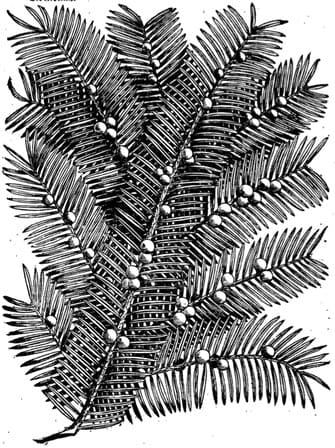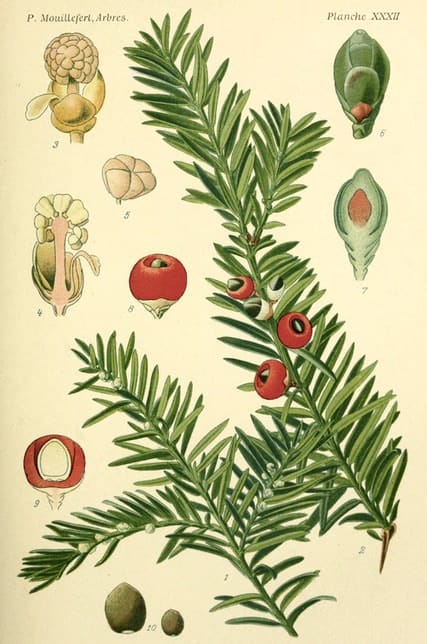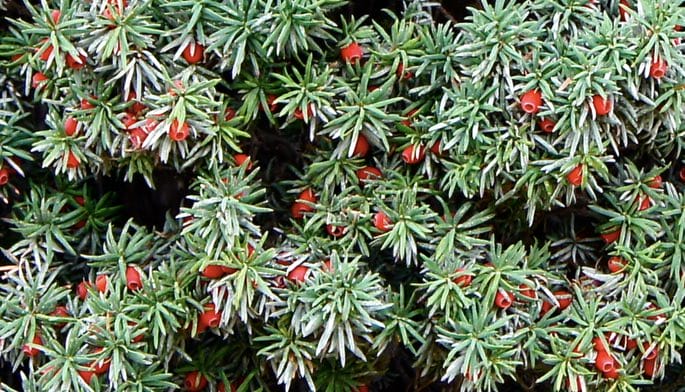Taxus, Yew treeMilax (Dioscorides)Sthauneya (Ayurveda) Thuner, Talispatr (Unani) Jiang Guo Zi Shan (TCM) Nan Fang Hong Dou Shan: Taxus wallichiana var. mairei (TCM) |

|

|
 New Kreuterbuch, Matthiolus, 1563
New Kreuterbuch, Matthiolus, 1563 Taxus baccata
Taxus baccataMouillefert, P., Traité des arbres et arbrissaux, Atlas, t. 32 (0)
 Taxus baccata
Taxus baccata(Photo by Jebulon) (Wikimedia)
Botanical name:
Taxus spp.
- T. baccata (European or English Yew)
- T wallichiana. (syn. T. baccata subsp. wallichiana) (Himalayan Yew) (Unani)
Parts used:
Pacific Yew is best used in Herbal Medicine as the toxic components (taxines) are far lower
Leaf (needles), Leafy Twigs, Branches
Fruit is occasionally used and is safe once the bitter, toxic seeds are removed.
Temperature & Taste:
Cool, dry. Bitter, Pungent, Sweet. Toxic
“Hot and Dry in the Second degree”. (Avicenna)
‘Venomous and against Man’s nature’. (Dodoens, 1578)
Constituents:
Alkaloids: diterpene esters of taxane type, ‘Taxine’ (0.6-2%), Ephedrine
Flavonoids inc. sciadopytisin, ginkgetin, sequoria flavone
Tannis, Resins, Sugars
Formic acid
Uses:
1. Clears Heat, Resists Poison: (West, TCM, Ayurveda)
-Boils, Abscesses, Chronic Skin diseases (Kustha), Blood diseases
-Burning Sensations, Thirst (Ayurveda)
–‘very useful in Typhoid, Quartan and Tertian fevers’. (Decoction, Avicenna)
-taken to prevent Cold and Flu (Unani)
-Malaria
-Hydrophobia (wood decoction)
2. Clears Damp, Settles Wind, Stops Spasms: (West, Ayurveda)
-Nervousness, Spasms, Epilepsy, Hysteria
-Vertigo, Meniere’s disease (diluted tincture)
-Rheumatism
-enhances Mental faculty and Memory in Ayurveda (Needles)
3. Clears Phlegm, Stops Cough and Wheezing: (West, Ayurveda)
-Chronic Bronchitis, Asthma
-proven bronchodilator effect
–‘Its oral intake proves to be useful in Consumption’. (Avicenna)
-jelly of the berries has been used for chronic bronchitis.
4. Moves the Blood, Clears Stasis: (West, Ayurveda)
-Amenorrhea, Dysmenorrhea
-has been used to induce abortion and as a Contraceptive
-Heart disorders (Siddha); Al-kindi listed it for Heart problems and Depression; it has an effect like Digitalis
-berries have been used for Palpitations
-Scrofula, Tumors, Cancer; listed for Cancer in API.
5. Benefits Stomach:
-Weak Digestion, Indigestion (Unani)
-Hiccup
6. Kills Worms: (West, Ayurveda)
-Kills Worms and Parasites, specifically Tapeworm
7. Externally:
-steam bath for Rheumatism
-Acne, Boils, Abscesses, Ringworm
Dose:
Leaf / Needle of T. baccata: 1–3 grams in Powder (API); Hager’s said 50–200mg several times daily, with 300mg being the largest single dose, and 1500mg being the largest daily dose.
Seed Powder: 25–100mg
Infusion of the Leaf: 2 parts in 100 parts
Tincture (1:5 in 98%): add 10 drops to 4 oz. of water and give in teaspoonful doses (Scudder, Specific Medicines)
Comment:
1. The original Latin name given to the Yew tree was Smilax, which was later changed and used for Sarsaparilla. Mullein was also known as Taxus barbatum.
2. The name Zarnab has been used for the Yew tree and Abies webbiana. There is some confusion over the identification of these two medicines.
3. Taxus species contain Taxol, used for cancer in modern medicine. However, it requires the bark of 3 mature trees to obtain just 1 gram of Taxol, and therefore, this ingredient is not effective in herbal medicine in the doses given.
4. Yew has been stated to have an effect like Digitalis on the Heart, strengthening and regulating it. It has the advantage of not being cummulative, however.
5. Khare in Indian Herbal Remedies raises doubt over the classical Sthauneya being Taxus baccata. Nevertheless, the Ayurvedic Pharmacopeia of India has a monograph on Taxus under that name.
Substitute:
1. It has been stated to be similar in use to Savin
2. Yew tree bark was used as a susbtitute for Tamarisk bark (Dodoens, 1578)
3. Avicenna said Yew is a substitute for Bliton (Amaranthus blitum) which seems unlikely.
4. Costus has been used as a substitute in India. (Khare)
Main Combinations:
1. To promote Menstruation, Savin extract (4 grains), Yew leaf powder (6 grains), powdered Licorice and clarified Honey, of each a sufficient quantity to make 6 bolues. Take one every 3 hours. (Brera)
2. Chlorosis, Amenorrhea, Yew leaf, Foxglove leaf, Savin, Iron carbonate (Neuman, Universal Formulary, 1850)
3. Stomach weakness, Indigestion, Yew leaf, Rose, Cyperus rotundus, Valerian, Mastic, Clove, Greater Cardamon (as in Anooshdaru Sada of Unani)
4. Lung Cancer (Non-small cell): Taxus wallichiana var. mairei Nan Fang Hong Dou Shan, Glehnia Bei Sha Shen, Ophiopogon Mai Men Dong, Lilium Bai He, Dendrobium Shi Hu, Hedyotis Bai Hua She She Cao, Citrus Chen Pi, Codonopsis Dang Shen (this is called Yang Yin Jie Du Decoction. It augments effect of gefitinib).
Major Formulas:
Yogoraja Guggulu
Anooshdaru Sada (Unani)
Anooshdaru Lulu (Unani)
Bala Taila (Ayurveda)
Mahanarayana Taila (Ayurveda)
Cautions:
1. Toxic. A spoonful of the fresh leaves has reportedly killed children. Seeds are poisonous, but the fruit without seeds has reportedly been eaten.
2. Not used during Pregnancy.
3. Not used in very young, very old, weak, or those with Kidney or Liver disease.
Toxicity:
1. Toxic dose of fresh Needles is 50–100 grams (PDF for Herbal Medicine)
2. LD50 of Pacific Yew powder could not be found in doses up to 5 gram/kg.
3. High doses are Cardiotoxic and can cause tachycardiac arrhythmia leading to cardiac arrest.
4. Common yew intoxication: a case report
5. Fatal heart block from intentional yew tree (Taxus baccata) ingestion: a case report
6. A fatal case of Taxus poisoning
7. Fatal ingestion of Taxus baccata: English yew.
Main Preparations used:
Tincture, Extract
1. Tincture of Yew
Dried Yew leaf, 1 part
Diluted Wine Spirit, 5 parts
Infuse, strain and press.
Click the Tabs above for more information on this Medicin
Herbal Simples, Fernie, 1897:
|
Although the Yew–a Conifer–which is so thoroughly English a tree, is known to be highly poisonous as regards its leaves to the humans subject, and as concerning its loppings or half-dead branches, to oxen, horses, and asses, yet a medicinal tincture (H.) is made from the young shoots, which has distinct and curative uses. Both the Yew and the Ivy were called abiga, because causing abortion. From which word when corrupted was formed ‘iua‘; and under this latter name, says Dr. Prior, the Ivy and the Yew became inextricably mixed up. Moreover, the red berries, or their coloured fleshy cups, are not poisonous when taken in moderation, but rejecting the seeds. Gerard says: “When I was yong, and went to schoole, divers of my school-fellows and likewise myself, did eat our fils of the berries of this tree, and have not only slept under the shadow thereof, but among the branches also, without any hurt at all, and that not one time, but many times.” Yet Leo Grindon says, much more recently: “Though the juice and pulp of the sweet and viscid berries are not harmful, still the seeds of the Yew, and the leaves are deadly poison.” In the ‘Herbal‘ of 1578, Lyte tells us the Yew is altogether venomous, and against man’s nature. “Such as do but only sleep under the shadow thereof become sick, and sometimes they die;” and, “the extract of yew is used by ignorant apothecaries to the great peril and danger of the poor diseased people.” The Yew tree (Taxus baccata) occurs in mountainous woods and rocky glens about Britain, but is rare as of native growth. Its name, Taxus, is a corruption of toxos, an arrow, since arrows in the old time were poisoned with the juice of yew. The tree was planted frequently by our forefathers in churchyards, because of its value in the manufacture of bows. It is exceedingly long lived, and often attains great magnitude of girth. A ghastly superstition was attached to the Yew when thus growing in a churchyard, that it would prey upon the dead bodies lying beneath its sombre shade. So Tennyson writes (In Memoriam):– “Old Yew! which graspest at the stones That name the underlying dead, Thy fibres net the dreamless head, Thy roots are wrapped about the bones.” The juice of the tree and of its leaves is a rapidly fatal poison, the symptoms corresponding in a very remarkable way with those which follow the bites of venomous snakes. No known poison but the Yew produces the lazar-like ulcerations upon the body, on which Marlowe lays such stress (Jew of Malta): “In few, the blood of Hydra-Herne’s bane, The juice of Hebron, and Cocytus’ breath, And all the poisons of the Stygian pool.” The witches in Macbeth include it in their accursed brew:– “Liver of blaspheming Jew, Gall of goat, and Slips of Yew.” The Yew tree is called “Hebon” by Spencer, and “Jew of Malta” by other writers of Shakespeare’s time. The leaves are bitter, nauseous, and acrid. The succulent |
covering of the fruit is soft and slimy, mawkishly sweet, and mucilaginous. The leaves have a dangerous effect on the circulation of the heart, and when taken with any freedom are as fatal as the Foxglove. Before the new Shakespeare Society, 1882, it was contended and proved to the satisfaction of the Society, that “the cursed Hebena,” the “leperous distilment poured into the chambers of mine ears,” told of, so pathetically, by the sad ghost of Hamlet’s father, was the poison of the Yew, and identical with Marlowe’s juice of Hebron. Ray mentions that a gardener employed in clipping a Yew tree at Pisa, could not proceed with his work for more than half-an-hour at a time without being seized with a violent pain in the head. Nevertheless, deer, sheep, and goats can eat the foliage with impunity. The fresh leaves were administered to three children near Manchester for worms. Yawning and listlessness came on, and the eldest vomited a little, but neither of them complained of any pain. They all died within a few hours of each other. Because being then green, on the Sunday next before Easter, the branches of the Yew tree have been used as a substitute for the Palms which symbolise the entry of Jesus into Jerusalem. The symptoms induced by provings of the leaves and juice in toxic quantities, have been sick headache, with giddiness, feeble, faltering pulse, coldness of the extremities, diarrhoea, and general prostration. So that for this combination of symptoms, as in severe biliousness, or as in the auditory vertigo of Meniere’s disease, small doses of the diluted tincture are found to give prompt and effectual relief. The leaves contain a volatile oil, tannin, and a bitter principle “taxina,” which is also furnished by the seeds. An extract of Yew has been pronounced a useful narcotic by more than one physician of repute: and in some parts of Germany a decoction of the wood is a well-known remedy against hydrophobia. A jelly prepared from the berries has been given for chronic bronchitis, and the leaves have been used for epilepsy; likewise they have been taken by ignorant persons to induce abortion, but with serious injury to the experimenter. In some rural districts the berries are known as “Snots”; whilst the wood and roots are “Wire thorn.” By an old statute of Edward the First, trees were required to be placed in churchyards to defend the church from high winds, the clergy being allowed to cut them down for repairing the chancel when necessary. Perhaps, partly for this reason, the Yew was commonly planted by the side of a newly-built church. That its wood was certainly employed for making bows, we learn from Shakespeare:- “Thy very beadsmen learn to bend their bows Of double-fatal Yew against thy state.” It was “double-fatal,” because the leaves and fruit seeds are poisonous, and the bows made from its branches, as well as arrows armed with its deadly juice, were instruments of death. Against the maladies which have been specified as indicating the tincture of Yew for their cure, from five to ten drops of the third decimal tincture should be given, with a spoonful of water, every two, three, or four hours, whilst required. In Switzerland the Yew is known as William’s tree, in memory of Tell. Formerly the name was spelt “Eugh,” “Yeugh,” and “Ewgh.” |
Bentley and Trimen, Medicinal Plants, Vol. 1., 1875:
|
‘Yew leaves and fruits have been given for their emmenagogue, sedative, and antispasmodic effects. Pereira says that therapeutically the yew appears to hold an intermediate position between savin and digitalis, being allied to the former by its acrid, diuretic, and emmenagogue properties, and to the latter by the giddiness, irregular and depressed action of the heart, convulsions, and insensibility, which it produces. Yew is, however, reported to have one decided advantage over digitalis by its effects not accumulating in the system; so that it is a much more manageable remedy than it. Besides its use as an emmenagogue and sedative in the same cases as savin and digitalis are administered, it has also been employed as a lithic in calculous complaints; and as an antispasmodic in epilepsy and convulsions. According to Dr. Taylor, yew-tree tea is sometimes used by ignorant persons to cause abortion. At the present time, however, yew is never used in regular medical practice, the principal interest attached to it |
having reference to its poisonous properties. Thus the leaves and young branches act as a narcotico-acrid poison, both to the human subject and some other animals, but more especially to horses and cows. Fatal cases of poisoning have also occurred from swallowing the fruit. It is frequently stated that animals may feed upon the young growing shoots with impunity, but that when these have been cut off, and left upon the ground for a short time, they are then poisonous. This is, however, an entirely erroneous notion, for yew shoots and leaves are poisonous both in a dried and fresh state. It seems certain, however, that the red succulent cup of the fruit is harmless, for a fatal case of poisoning has been recorded of a child from swallowing the entire fruit with its contained seed; whilst other children who had partaken of the fruit at the same time, but who had rejected all but the fleshy cup, suffered no ill effects. |
